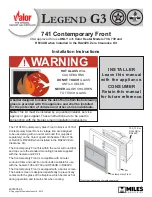
15
Be in charge.
Super B.
!
Caution!
Bluetooth range is strongly dependent on the environment and how the Li-ion
battery is positioned. Metal parts such as battery boxes, covers and cabling can affect the
Bluetooth range and can lead to reduced range. The mentioned range only applies to an
“open field situation”, and can be less or more depending on the situation.
3.6.5. Modes and states of the Li-ion battery
The Li-ion battery knows two modes: operational and non-operational.
Non-operational mode
If the Li-ion battery is in non-operational mode, it cannot be used anymore. This can happen
if the BMS detects a malfunction in the battery’s monitoring and control, or when a deep
discharge has occurred which led to cell damage. A deep discharge occurs when one of the
cell blocks is 1.5V or lower. This is even possible when the Li-ion battery is at 10V. The Li-ion
battery will store the state internally. The Li-ion battery is not usable anymore. The battery’s
protective disconnect device is non-conducting.
Operational mode
The Li-ion battery knows 3 states in operational mode:
•
Normal state: the units the Li-ion battery monitors (voltage, current and temperature) are
within the operational level of the cells and other components in the Li-ion battery.
•
Warning state: the units the Li-ion battery monitors are threatened to go beyond the
operational level of cells or other internal components. The battery’s protective disconnect
device will stay on.
•
Alarm state: the units the Li-ion battery monitors are beyond the operational level of cells or
other internal components. The battery’s protective disconnect device will disconnect the
cells from the terminals and the Li-ion battery. It can be that charging is disabled, discharging
is disabled, or both are disabled.
Charging disabled causes
Charging disabled causes are triggered in the following events:
•
Overcurrent during charging, the charge current is too high
•
Overvoltage due to charging, the charger is too high in voltage or battery cells can be out of
balance
•
The temperature to be able to charge is too high or too low
Discharging disabled causes
Discharging disabled causes are triggered in the following events:
















































